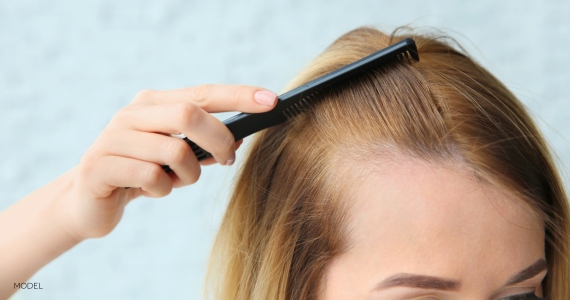Female hair loss can be a distressing experience, but advances in medical technology have made hair restoration a viable solution for many women. Female hair transplant procedures are on the rise, which we are seeing across the industry and in our office. More women are pursuing hair restoration to treat their hair loss at an earlier point. At the Quatela Center for Hair Restoration, surgeons Drs. Quatela, Lee, and Montague specialize in providing tailored solutions to help women regain their confidence and achieve natural-looking results. Here are the top three things you need to know about female hair transplants:
Female Hair Transplants are Trickier Than Male Transplants
Female hair transplants are more difficult than male hair transplants, due to the pattern of hair loss (thinning all over instead of in one spot), hair type, and hairline shape. For this reason, it’s especially important for women to choose a qualified surgeon and hair team.
We utilize the latest hair transplant techniques to ensure natural-looking results with minimal discomfort and downtime. The two most commonly used techniques for female hair transplants are Follicular Unit Extraction (FUE) and Follicular Unit Transplantation (FUT).
- Follicular Unit Extraction (FUE): This minimally invasive technique involves extracting individual hair follicles from the donor area (usually the back and sides of the scalp) and transplanting them into the thinning or balding areas. FUE leaves tiny, virtually undetectable scars and has a shorter recovery time.
- Follicular Unit Transplantation (FUT): Also known as strip harvesting, FUT involves removing a strip of scalp from the donor area, from which individual follicular units are dissected and transplanted. FUT can provide a higher yield of grafts in a single session, making it ideal for patients needing extensive coverage.
Our board-certified surgeons have extensive experience with both techniques and will recommend the best option based on your hair loss pattern, donor hair availability, and personal preferences. We also employ an in-house hair team that is dedicated to solely working with Drs. Quatela, Lee, and Montague and hair restoration patients, ensuring undivided commitment to the patient and continuity of care.
Natural-Looking Results are Within Reach
Achieving natural-looking results is our top priority. Our surgeons meticulously place each graft to mimic the natural growth pattern of your hair, ensuring that the transplanted hair blends seamlessly with your existing hair.
- Artistic Placement: The direction, angle, and density of each graft are carefully planned to create a natural hairline and restore volume. This artistic approach is essential for achieving results that look and feel authentic.
- Post-Transplant Care: After the procedure, we provide detailed instructions and support for post-transplant care to ensure optimal healing and hair growth. Follow-up appointments are scheduled to monitor progress and address any concerns.
In addition to the surgical procedure, we will clearly explain the recommended non-surgical treatments to enhance the results and promote overall scalp health.
Pharmaceutical Therapies are Critical
Hair loss in women can be caused by a variety of factors, including genetics, hormonal changes, stress, and medical conditions. Unlike men, women often experience diffuse thinning rather than specific bald patches. Therefore, a one-size-fits-all approach doesn’t work for female hair restoration. Since we want to keep all the existing hair to properly treat the diffuse hair loss pattern, regenerative and pharmaceutical therapies, or medical management, are essential to the treatment plan.
Our surgeons conduct a comprehensive evaluation to determine the underlying cause of hair loss and design a customized treatment plan tailored to each patient’s unique needs.
- Consultation and Diagnosis: The process begins with a thorough consultation and scalp analysis to identify the pattern and extent of hair loss. Blood tests and other diagnostic tools may be recommended to rule out underlying medical conditions. TrichoTest™ is available to give an in-depth analysis of your DNA, allowing us to personalize our recommendations based off which medications and supplements will work best for you.
- Personalized Approach: Based on the diagnosis, we develop a personalized treatment plan that often include a combination of hair transplant techniques, medical treatments, and lifestyle changes to promote hair growth and prevent further loss. Common medical therapies include: Nutrafol® supplements, Rogaine® (Minoxidil), and Formula 82M® Topical Hair Loss Medication.
Female hair transplants offer a promising solution for women struggling with hair loss. With a customized treatment plan, advanced techniques, and a focus on natural-looking results, our board-certified surgeons are committed to helping you achieve your hair restoration goals. If you’re considering a hair transplant, schedule a consultation to explore your options and take the first step toward regaining your confidence.

Leave a Reply